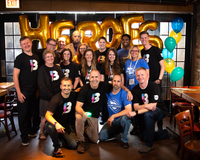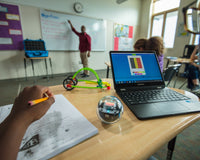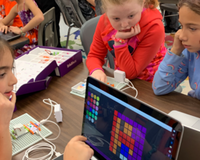Technology is evolving at a rapid pace. But as the devices we use in education become more sophisticated, it’s important to stay conscious of how people learn, and how they best integrate and maximize new innovations. Without this awareness, the tech (and students) won’t reach their full potential.
How people learn goes beyond learning styles and delves into what the brain’s ability is to function a particular way. Naturally, the process is complex and heavily nuanced for each student. One example is the theory of Multiple Intelligences, developed in 1983 by Howard Gardner, a Harvard psychologist. The theory emphasizes that intelligence is not a fixed, one-dimensional element that can be tangibly measured. Because of this, in the classroom, the theory has massive implications and impacts on learning when compared to the idea of a singular “general” intelligence.
An understanding of multiple intelligences can offer teachers, students, and parents a way to reflect on their own strengths—and areas for improvement—and consider how intelligences impact how they learn in STEM education.
A Quick Summary of Multiple Intelligences Theory
The theory of Multiple Intelligences (MI) is, in part, a reaction to the theory that there is one type of intelligence—and that it can be measured by IQ or other tests. MI states that humans have “significant intellectual capacities”.
Gardner uses a metaphor of a computer to demonstrate the point. He claims that human intelligence is not like a single, general-purpose computer that functions at a high, medium, or low level. Instead, intelligence is like having several relatively independent computers that can perform at different levels, and the level of one computer does not impact that of another.
Gardner’s Types of Intelligence
Gardner initially proposed eight different forms of intelligence (he has since suggested more, but hasn’t yet collected data about them). They are as follows, complete with examples of experts who display each form of intelligence:
- Bodily-kinesthetic (e.g. a ballet dancer)
- Interpersonal (e.g. a successful psychologist that excels at understanding people)
- Intrapersonal (e.g. a reflective, self-confident person who understands their needs)
- Linguistic (e.g. authors and people that speak multiple languages)
- Logical/mathematical (e.g. scientists, mathematicians, machine learning engineers)
- Musical (e.g. talented artists that write lyrics, sing or play instruments)
- Naturalist (e.g. marine biologists, zoologists, park rangers)
- Spatial (e.g. architects and engineers)
Why Is the Theory of Multiple Intelligences Still Relevant Today?
Despite MI being developed 40 years ago, it is still widely discussed in education and even adapted for new sub-theories. Gardner started his work by studying whether one, single intelligence exists—one that can be measured by a particular type of test. From there he developed his theory that this is an incomplete study of intelligence and that not everyone’s cognitive abilities can be accurately measured by these tests. Whether or not people subscribe to Gardner’s theory, his critique remains valid—and given how complicated humans are—holds some degree of truth.
Chris McCormick, Education Content Manager at Sphero, explains that one of the longstanding critiques of Gardner’s theory has been the lack of psychometric assessments that support the different intelligences. “This is in stark contrast to the decades of empirical research that support a ‘general intelligence,’” he says. Gardner hasn’t created tests to measure MI and acknowledges how difficult that would be.
However, as neuroscience has progressed, there is evidence to suggest that different regions of our brain light up as we complete tasks associated with Gardner’s Multiple Intelligences.
While more research is needed to conclusively support the existence of MI as Gardner defines them, his theory still matters today because it stresses that each student is unique and needs a variety of tools to address those needs. “There is not one measure for success, nor is there one way to learn something,” Chris adds.
“How many of us learn anything after one exposure to it? As educators, we’ve dedicated our lives to teaching and our practice is improved through collaboration with others, reading research, engaging with and learning from our students, teaching others, listening to podcasts, and so on,” he says. “To gain mastery in something requires a lot of work in many different mediums over a long period of time – and that is true for learners of all ages.”
What’s the Difference Between Multiple Intelligences and Learning Styles?
Chris says that MI differs from learning styles because it does not center on the preference of how a student learns. Alternatively, the theory discusses how the brain is wired to gather, process, and store information.
“Still,” Chris says, “both view humans as complex individuals and agree that there is not a singular, fixed ‘general’ intelligence that can define us—just as there is not one way to learn a concept. We all come with differing arrays of background knowledge that has been developed over years and is influenced by both genetics and environmental factors.”
He continues, “This is the thing we should take away from MI and learning styles. Human beings are complex and learning is hard – if we want to be effective educators, we need to see the complexity in our students and adapt our instruction to meet their needs. This is one of the biggest challenges we face as teachers, but it is one we must tackle if we want our students to succeed.”
Chris also warns of being cautious in how MI and learning styles are applied. “Both are rooted in an understanding of the individuality of every human, but if taken too far, they can be used as a box to limit a student's potential. For example, if I take a test that tells me I’m a kinesthetic learner, that doesn’t mean that I can only learn through some sort of physical activity,” he says. “Likewise, if I identify linguistic intelligence as a strength of mine, that doesn’t mean it is the only area in which I can excel or grow.”
The dynamic nature of intelligences is at the foundation of Gardner's theory and the fear of labeling students is one of the reasons he has avoided developing MI assessments. One of Gardner’s primary concerns is that creating tests for intelligence (like IQ tests) “may lead to new forms of labeling and stigmatization [...] intelligences should be mobilized to help individuals learn important content and not used as a way of categorizing individuals.”
With that in mind, Chris suggests that educators reflect on how best they learn and ask students to do the same. “From there, begin to adapt and modify instruction and assessments correspondingly to meet the needs of students,” he says, “which is a pretty intelligent thing to do!”
Applying the Multiple Intelligences Theory to STEM Learning
In thinking about how to apply MI to STEM learning, Chris recommends educators introduce students to concepts and allow for opportunities to interact with those concepts over a longer period of time and in a variety of ways.
He provides an example, “If I’m teaching Python and I introduce a For Loop as a way to repeat an action as many times as needed, I shouldn’t just verbally explain it and assume that all my students will understand and retain the information.”
“After my explanation, I may have students explain it to one another or watch an instructional video by someone else who explains it in a different way. Students could also look at a snippet of code, make a prediction, run it, discuss it, modify it, and then use a For Loop to change the behavior of a robot – this way, students can see the physical manifestation of their code.”
Chris also highlights the importance of revisiting what has been taught. “Don’t expect that something that was introduced in September will still be understood in June unless there are opportunities to practice in the interim. Repeated exposure in a variety of contexts over a long timeframe helps ingrain concepts and ensures understanding,” he explains.
Sphero robots provide excellent opportunities for students to learn many different things in many different ways. The collaborative nature of sharing a robot and working toward accomplishing a goal strengthens linguistic, and intra and interpersonal skills. The critical thinking and problem-solving that goes into modifying and building code to achieve a goal requires logical and mathematical thinking. Meanwhile, designing and engineering physical spaces for robots builds spatial understanding. Each of these opportunities offer fun and engaging ways to encourage growth across different intelligences, and for students to interact with lessons that speak to their own unique intelligence pattern.
Discover how Sphero robots can open up learning pathways for multiple intelligences in your classroom.










